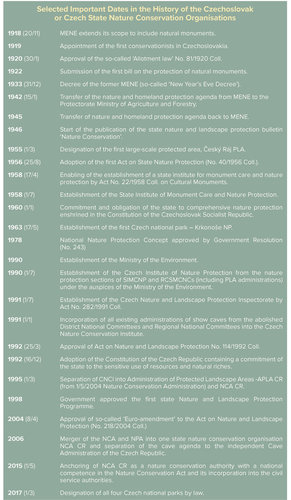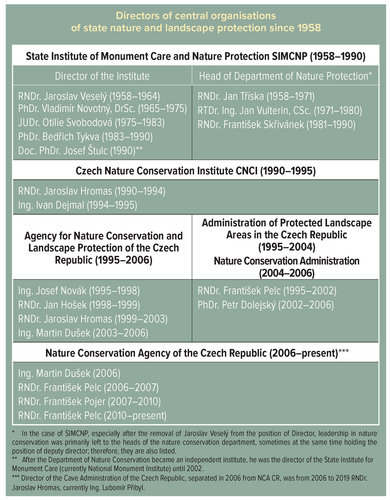Nature Conservation 2020 — 25. 3. 2020 — Research, Surveys and Data Management — Print article in pdf
Sixty Years of History of State Nature Conservation Organisations in the Czech Republic

The so-called ‘Eight’ year (2018) was significant not only for several anniversaries in Czech statehood (1918, 1938, 1948, 1968), but also for nature protection. The foundation of our oldest forest reserves, Žofín Forest (1838) and Boubín Forest (1858), was commemorated by the Year of Czech Primeval Forests.1 The anniversary of the founding of the first national professional state institution for nature conservation in 1958 remained somewhat in their shadow. After 1989, the overall preparedness of nature conservation institutions helped to enforce rapid changes in the environment and to establish modern legislation and nature conservation management in the Czech Republic.
The beginnings of the history of Czechoslovak and later Czech state nature conservation are connected with the establishment of an independent republic in 1918. By a resolution of the Ministerial Council of the newly established Ministry of Education and National Enlightenment (MENE) in Prague on 20th November, the competence of this office and subordinate bodies was extended to natural monuments. This important step was taken on the initiative of Zdeněk Wirth2, an important art historian, employed by MENE as section director responsible for the organisation and management of monument care. Already in 1919, conservationists were appointed (both for the whole state and for each county) for two years (Procházka 1926). In the same year, Z. Wirth appointed an external expert for nature conservation, Rudolf Maximovič, to MENE, and entrusted him with tasks in the protection of elements deserving protection in land reforms. In 1920, the Allotment Act was passed, which heralded the emergence of a number of specially protected areas3. During the First Czechoslovak Republic, intensive efforts were made to adopt special legislation for the protection of nature, but all attempts, often conducted up to interdepartmental discussion, were unsuccessful (Anonymous 1921, Procházka 1926, Klika 1946, Veselý 1954, Pešout 2013). In 1922, R. Maximovič joined the Ministry as officer for the protection of natural monuments (Maximovič 1934), where he worked until 1942, unfortunately until 1935 as the only officer of nature conservation (Anonymous 1941, Čeřovský 2012).
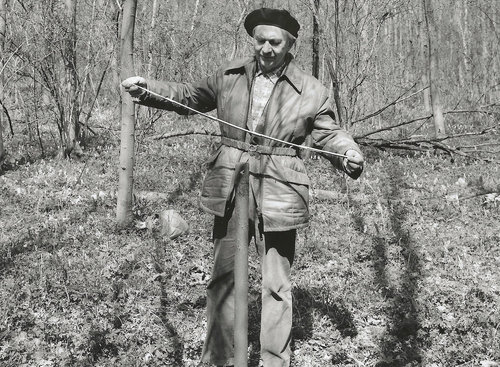
Zdeněk Vulterin (during monitoring at Loužek SNR) led state nature
protection in the years 1971–1980. Photo Václav Petříček
In 1939, the German Reich nature protection regulations were extended to the Sudetenland and at the offices of ‘government presidents’ in Karlovy Vary, Ústí nad Labem and Opava, ‘higher nature conservation authorities’ were established. In 1942, in accordance with the German Reich Nature Conservation Act of 1935 (Maximovič 1939 a, b, c), the nature and homeland protection agenda was transferred to the competence of the ‘chief forester’, i.e. the Ministry of Agriculture and Forestry4.
After the liberation, state nature protection returned to MENE, where R. Maximovič again led it until 1948 as the general conservator of nature protection5 (Stejskal 2006). After his retirement, Maximovič’s pupil and co-worker Jaroslav Veselý became the head of nature conservation at MENE (from 1942, Stockmann 2013). In 1946, the conservators were re-appointed by the Minister, and the state nature and landscape protection gazette ‘Nature Protection’ was first published (Čeřovský & Veselý 1970, Pešout 2012) and in 1951, the Department of Nature Conservation was established at the then State Heritage Office in Prague, which was led by Jaroslav Veselý until 1958 (Veselý 1954, Čeřovský 1981).
In 1956, Act No. 40 on State Nature Conservation was finally adopted, in 1958 followed by the Act on Cultural Monuments, which constituted the State Institute for Monument Care and Nature Protection (SIMCNP).
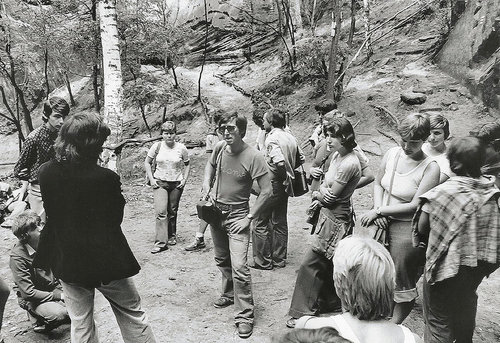
Field excursion of Brontosaurus members in Český ráj PLA in 1975.
Photo Zdeněk Thoma
State Institute for Monument Care and Nature Protection
SIMCNP was established by the Ministry of Education and Culture by the Act on Cultural Monuments No. 22/1958 Coll. (§19) from 17/4/19586. Its mission in the field of state nature protection pursuant to the aforementioned Act and the Statute7 issued in the same year was to assess, elaborate, as appropriate, professional documents for the proceedings and decisions of state nature protection bodies, provide them with professional and methodological assistance, organise and conduct research, exploration, and documentation, in particular as regards nature as a whole and parts thereof, intact or untouched by human activity, the impact of human activity on nature and on countering the adverse effects of human activities, especially research, exploration and documentation of protected parts of nature, the biology of protected organisms, and research into and scientific documentation of large buildings and industrial areas.
It was lucky for nature protection that Jaroslav Veselý, professional nature conservationist (Maršáková-Němejcová 1966, Tříska 1966, 1986, Toman & Tomanová 1976), became the first director of SIMCNP. Although some colleagues blamed him for anxious tolerance of heritage preservation, as a result of which the field of nature protection was not strengthened (Čeřovský 2014). However, he was clearly under pressure from the real demands of that time. Thousands of heritage sites of unquestionable value, which were under the administration of regions and towns, required appropriate procedures, and often immediate solutions to ensure their rescue. The damage to heritage buildings was also more pronounced than the gradual devastation of nature and landscape. Nevertheless, it should be noted that this period was extremely important for state nature conservation, through building the nature protection department in SIMCNP, and also in the creation of nature conservation units in Regional Centres of State Monument Care and Nature Conservation (RCSMCNC). Jaroslav Veselý also contributed to international cooperation, including the IUCN membership of SIMCNP as early as 1958.
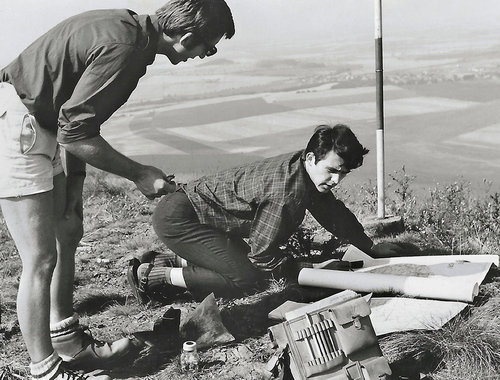
Jaroslav Hromas (right) and Václav Petříček in 1973 during the delineation
of České středohoří PLA. Photo archive of Václav Petříček
All activities in nature conservation at SIMCNP were initially carried out by a department of 14 staff. This was led by Jan Tříska (Skřivánek 1982a, 1986), Zdeněk Vulterin (Skřivánek 1982b, Petříček 2017) and later by František Skřivánek (Kučera 1994). In addition to all assessment activities for decision-making by the Ministry of Culture, initial efforts were focused on the proclamation of the Krkonoše National Park, and in cooperation with the RCSMCNCs on the assessment and supplementation of the Protected Landscape Area (PLA) system, as well as small-scale protected areas (nature reserves). Surveys of nature reserves were started, and a system of verification of their condition was set up; gradually the basics of monitoring and documentation were laid out8.
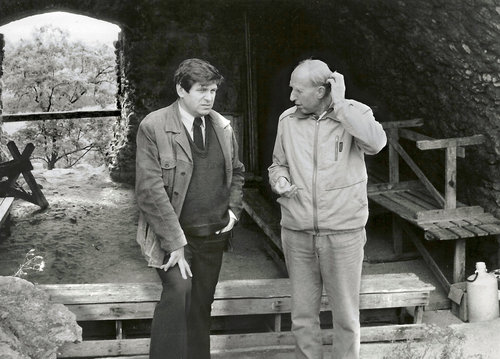
Director of SIMCNP Bedřich Tykva and Vojen Ložek on a visit to the Zvířetice
castle ruins in 1988. Photo archive of Václav Petříček
In the 1980s, active species protection programmes were launched, in cooperation with regional centres, the Czech Union for Nature Conservation (CUNC) and others9 and the first rescue facilities for injured wild animals were built. The gene pool conservation strategy was developed, Red Lists of Endangered Species were produced and 5 volumes of Red Books were gradually published.
By engaging in the state electronisation programme, a remote sensing laboratory (RSL) was set up10, later becoming the basis for today’s Nature Conservation Information System department. In the early 1980s, SIMCNP also began work on the new Nature Conservation Act11. In 1986, a partial but substantial amendment to the State Nature Protection Act was adopted (No. 65/1986 Coll.), the so-called ‘sanction amendment’, regulating sanctions for violations of the law (Friedl & Damohorský 1987).
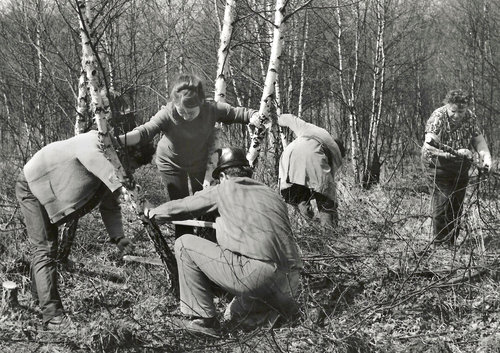
Removal of trees and shrubs at Sluneční dvůr NM by SIMCNP staff in 1971.
Photo archive of Václav Petříček
A certain problem was the lack of clarity of the competences of the independently operating SIMCNP and RCSMCNCs, which the Institute tried to counteract by holding methodical meetings and consultations. Bureaucracy was further increased after 1980, when, in order to improve the care of monuments, the Headquarters of State Monument Care and Nature Protection was established, which only worsened the communication between SIMCNP and the Ministry of Culture.
In international cooperation, the work of Jan Čeřovský should be mentioned, who in 1969, as a reward for his educational activities, became an employee of the IUCN Secretariat, from where he was withdrawn by our state for political reasons in 1973. In 1988 he was elected a member of the IUCN Council and for one term he was IUCN Vice President (Kučera 1990).
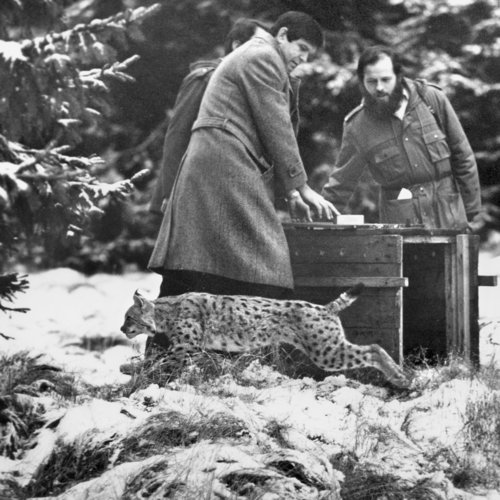
Releasing a young male lynx near Horská Kvilda in November 1985.
Photo Ivo Svoboda
Regional Centres of State Monument Care and Nature Conservation (RCSMCNCs)
In the regions, the executive state bodies of nature protection were the Departments of Education and Culture of Regional National Committees (DEC RNC). The staff member (usually one in each region) was called a nature conservation inspector. Similarly, the District National Committees included nature conservation inspectors – often including other agendas, such as the role of ‘church secretaries’). The years 1958–1961 saw the gradually emergence of RCSMCNCs, part of which were the PLA administrations. The Krkonoše National Park was also administered by the Regional National Committee.
Regional centres were methodologically led in their activities by SIMCNP and primarily provided expert support for decision-making by regional and district national committees, conducted natural science surveys and assessments of the state of nature, cooperated on preparation of new protected areas incl. PLAs (Eberhard 1984, Kuncová 1984, Macák 1985, Podzemný 1985, Polák 1984, Rivola 1985, Strejček 1985). Even though the number of RCSMCNC staff was increasing gradually, a substantial part of the field work was still dependent on voluntary groups of district conservators and nature conservation reporters until the early 1990s (Tříska 1983, Čeřovský 2004).
Difficult journey to consolidating state nature protection
In 1990, the Ministry of the Environment came into being and the Nature Protection Department SIMCNP became the basis of the Czech Nature Conservation Institute (CNCI). CNCI was established on 1st July 1990 and on the same date the nature protection departments of the abolished RCSMCNC, including PLA administrations, were integrated into it. From 1st January, 1991, the newly constituted structure of state nature conservation was extended to include all existing administrations of show caves, in contradiction with the original idea that, following the example of Slovakia, an independent cave administration would be established in the institute (Hromas 2013). Although the separation of heritage care and nature conservation into different institutions was undoubtedly the right step, it has become clear over time that interdisciplinary cooperation in the care of our common cultural and natural heritage is necessary in many cases (Pešout 2011).
A fundamental change came with the new Act on Nature and Landscape Protection No. 114/1992 Coll., which, from 1st June 1992, introduced the institute of special state administration in nature protection, incl. definition of the competencies of PLA and NP administrations. Adoption of a new modern legal standard in nature and landscape protection would not have been possible without the previous decade of preparation and without the overall preparedness of state nature conservation to promote extensive changes in ensuring environmental protection. However, the newly adopted Constitution of the Czech Republic six months later stipulated that administrative authorities can only be established by law. Although the previously established PLA and NP administrations did not cease to exist, their legal status became constitutionally non-conforming and required revision. This should have occurred in a ‘reasonable time’. First, in 1995, the CNCI department managing the PLA administrations was separated into a newly established organisation – Administration of Protected Landscape Areas in the Czech Republic (APLA CR), while the other part of the Institute became the basis for the Agency for Nature Conservation and Landscape Protection of the Czech Republic (ANCLP CR), which provided professional support for the performance of state administration. APLA CR had an amendment to the Nature and Landscape Protection Act prepared, but despite two attempts it did not pass through the legislative process. A further effort to remedy this in 2004 did not pass in the Chamber of Deputies by one vote (Pelc 2016)12. However, this so-called ‘Euro-amendment’ ensured the transposition of European Natura 2000 directives into Czech law, and, inter alia, shifted the granting of exemptions from prohibitions in the protection of protected species from the Ministry of the Environment to the PLA and NP administrations. In this context, from 2004 APLA CR was renamed to Nature Protection Administration (NPA) (Moucha 2004).
Nature Conservation Agency of the Czech Republic (NCA CR)
In 2006, following the changes in nature protection after the establishment of regional self-governing units (1st January 2000) and after the accession of the Czech Republic to the EU (1st May 2004), steps were initiated to establish a special state administration body in nature conservation with nationwide competence. The aim was to strengthen state nature conservation as an institution containing all the necessary pillars – professional background incl. monitoring and documentation, competence for direct performance of state administration and providing care incl. financing and, last but not least, public education. In these years, both organisations - ANCLP CR and NPA – faced repeated serious dismantling proposals as part of efforts to develop other forms of environmental governance.
First, in 2006, the Minister of the Environment merged the two state nature protection organisations into one organisational unit of the NCA CR. At the same time, operation of publicly accessible caves incl. their research and documentation was entrusted to the newly established contributory organisation Cave Administration of the Czech Republic (Hromas 2008). This clearly separated the performance of the state administration from the operation of visitor circuits, which was appropriate not only from a nature conservation perspective, but mainly for operational and economic reasons.
Even after the constitution of the NCA CR, efforts to enforce its establishment by law continued. Unfortunately, the 2009 amendment was again not approved. Only the administration of National Nature Reserves (NNR) and National Nature Monuments (NNM) was transferred from the Ministry of the Environment (MoE) to NCA CR, and only a few other small changes were accepted. In connection with the discussion of the twelve years postponed Civil Service Act (No. 234/2014 Coll.), finally a decision had to be made on the definitive position of special state administration bodies in nature conservation. In the case of national park administrations, economic and economic reasons prevailed and they remained outside the scope of the Civil Service Act, but in the case of NCA CR the choice was clear. The management of the organisation sought to establish the NCA CR as a civil service office, which, through Act No. 250/2014 Coll. happened. The position of the civil service office brought higher bureaucratization of internal processes, but the benefits of long-term stable anchoring and the inclusion of nature protection on a par with other institutions of special state administration undoubtedly significantly prevail.
Efforts to ensure institutional nature conservation
In 2017, we managed to discuss the so-called ‘national park’ amendment to the Nature Protection Act and to designate all four national parks by law. Along with the NCA CR legislation, the sustained efforts of many professional and voluntary conservationists and natural scientists to ensure the long-term stabilisation of institutional nature protection in the Czech Republic over a quarter of a century have finally come to fruition. It is good to remember today that in the beginning, sixty years ago, state nature conservation was lucky to have several personalities and nature conservation teams at headquarters and regional centres, who were convinced of the necessity of their work and passionate about it. The readiness of state nature conservation to promote changes after 1989 would not have been possible without the existence of joint professional institutions with monument care. In the period of building socialism, life was not a bed of roses for either of the disciplines, but despite this the staff of SIMCNP and RCSMCNCs managed to protect a significant part of our cultural and natural heritage. This is the right place to thank all professional and volunteer nature conservation workers, both contemporary, and especially our predecessors, without whom we could not have raised the safeguarding of nature and landscape protection to the level of the most advanced countries.
Acknowledgments
I would like to thank my colleagues Bohumil Kučera, Jaroslav Hromas and Václav Petříček for comments on the article.
A list of documents referred to is attached to the web version of the article at
www.casopis.ochranaprirody.cz
Notes:
1 A comprehensive series on annual excursions for the Year of Czech Forests by Tomáš Vrška et al. was published in six issues of Živa magazine in 2018.
2 PhDr. Zdeněk Wirth remained at MENE until 1939, when on his departure; the President of the Republic thanked him for his merits (Anonymous 1939).
3 The Act of January 30th, 1920, which was issued in accordance with § 10 of the Act of April 16th, 1919, No. 215 Coll., the provision on the allocation of seized land and regulating the legal relation to the allocated land (the so-called ‘Allotment Law’) in § 20 obliges land authorities “The allotment shall not disturb the beauty of nature or the character of the landscape and not harm the natural, historical and artistic monuments. The Land Office may authorise to this end the areas devoted to parks, nature parks, which otherwise serve to embellish the landscape, or the purpose of which is to preserve an example of the original character of the landscape, or to secure and protect historical monuments and their surroundings closely related to them, may be left in the ownership of its original owners, in addition to the land area, which pursuant to § 11 of the Act of 16th April 1919, No. 215 Coll., may be left to its original owners and not confiscated, if the owner complies with the conditions set by the Land Office in agreement with the participating ministries, as regards the accessibility of those places to the general public, scientific and artistic staff, or uses them for humanitarian purposes” and at the same time had the option according to § 50, “to establish a special order on management ... protection of natural and artistic monuments, preservation of landscape character and landscape specialties in buildings ... and so on.”
4 Under Government Decree No. 14 of 15th January 1942 on the new organisation of some central offices, Coll. Protectorate of Bohemia and Moravia 1942, pp. 75– 80 and Government Decree No. 208 of 15th March 1942 on the new organisation of certain central offices (‘reorganisation regulation’), Coll. Protectorate of Bohemia and Moravia 1942, pp. 997–1003.4)
5 After 1946, the title of his position was changed to “Central Conservator of State Nature Conservation” (Čeřovský 2004).
6 Originally, two institutes were to be established; one for monument care and one for nature conservation. However, at a meeting of the ministry management, one common institute was eventually promoted (Kučera 1998).
7 Decree of the Ministry of Education and Culture of 28 August 1958, ref. 38736/1958-E 1, MSK XIV Journal, 277.
8 As of 1990, 1 NP and 17 PLAs were designated and 13.5% of the territory of the country was covered by protected areas.
9 In cooperation with the Research Institute of Audio and Video Technology, aerial photography was commenced in 4 bands of the spectrum up to a scale of 1:25,000 and the production of derivatives for use at a scale of 1:5,000. On the example of Jizerské hory PLA, possible evaluation of the degree of damage to spruces by emissions was verified from the produced derivatives. At that time, no other organisation in Czechia was able to do that. In the mid-1990s, other Protected Landscape Areas and the Krkonoše and Šumava National Parks were photographed. In the 1990s, the RSL was transferred to building the GIS system.
10 Programmes Lynx (gradual repatriation of Eurasian lynx to Šumava) and Haliaeetus (stabilization of white-tailed eagle in Třeboňsko), as well as the programmes Tetrao, Lutra, Otis, Falco and Margaritifera (Trpák 1989).
11 The main activities of SIMCNP in the field of nature protection were described by the Deputy Director for Nature Conservation at that time, František Skřivánek (1983).
12 The only fully-fledged special nature conservation authority was the Bohemian Switzerland National Park Administration, which was established by a separate Act (No. 161/1999 Coll., declaring the Bohemian Switzerland National Park and amending Act No. 114/1992 Coll., on Nature and Landscape Protection, as amended).


